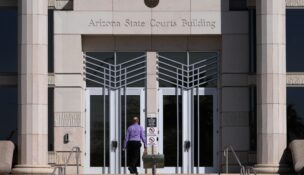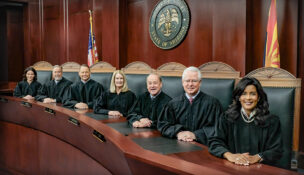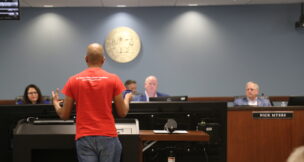Rural roots could be factor in choosing next Supreme Court justice
Kiera Riley Arizona Capitol Times//November 29, 2024//
Rural roots could be factor in choosing next Supreme Court justice
Kiera Riley Arizona Capitol Times//November 29, 2024//
When Justice Robert Brutinel left the Arizona Supreme Court in October, he took with him decades of experience working as a judge and attorney in rural Arizona. Now, all six remaining justices hail from Maricopa County.
In addition to merit, the Commission on Appellate Court Appointments is tasked with considering the diversity of the state’s population in sending state Supreme Court nominations to the governor.
There is no written requirement that the commission weigh geographic background, but historically the bench has had at least one justice with roots outside of the state’s most populous county.
Ahead of advancing eight Supreme Court applicants to the interview stage, commissioners identified a tie to rural Arizona as one potentially crucial attribute, especially given the state high court’s ongoing goal to address disproportionate access to justice.
“The rural perspective is increasingly important,” chair of the commission Chief Justice Ann Timmer said. “It’s one of the puzzle pieces that you’re looking for in putting together the court.”
Brutinel retired from the court on Oct. 31. Prior to his time on the bench, he worked as an attorney in Prescott and spent 14 years as a Superior Court judge in Yavapai County.
Constitutional provisions require commissioners to consider merit first, but further consider “the diversity of the state’s population.”
In past lineups, the state Supreme Court has typically had at least one justice from outside Maricopa County. Beyond Brutinel, former Justice Andrew Gould brought experience as a longtime judge in Yuma County, former Justice John Pelander hailed from Pima County, as did former Justices Thomas Zlaket and Stanley Feldman.
Pelander noted there are no provisions requiring a geographically diverse Supreme Court, and in practice, a person’s geographic location did not make a substantive difference in applying the law.
“But that said … it’s not called the Maricopa County Supreme Court, or the Phoenix Supreme Court,” Pelander said. “At least from a perception standpoint, in an ideal world, it’s nice to have a little bit of geographic diversity.”
He said, in his experience, having a varied geographic perspective could come into play in getting into the minutiae of court rules.
“Sometimes a rule or a rule change, or whatever would make sense (in) a larger jurisdiction, but not a smaller one, or vice versa. And so sometimes it’s good to have that diversity of thought and input and experience statewide to even weigh in on those kinds of issues when it comes to rule making,” Pelander said.
He continued, “But when it comes to the nuts and bolts of what the court does, which is deciding whether or not to grant review in cases, and then once review has been granted, actually hearing the case and digesting the briefs and coming up with a decision and so forth. I didn’t see, in my years up there, any real difference based on where people were from.”
But with access to justice as a priority at the top of both Brutinel and current chief justice Timmer’s strategic agendas, a rural perspective becomes a more important perspective to have on the court.
The point came up at the commission meeting Nov. 22, in discussing an application from Court of Appeals Judge Maria Elena Cruz. Cruz hails from Yuma County, previously serving as presiding judge, Superior Court judge, public defender and a prosecutor for the county.
Commissioner Jill Harrison, who previously served on the commission from 2007 to 2011, noted the point of geographic background came up when vetting and eventually sending Brutinel up to the governor.
“I do think that there is a different experience in rural Arizona,” Harrison said. “It was something that I had to raise with other members of the commission at the time, to really think about how different it is to live in areas where people travel hours and hours and hours just to get to a lawyer, to a courthouse.”
Timmer pointed out Arizona’s low rank in attorneys per capita. In 2024, the American Bar Association ranked the state toward the bottom of the list with about 2.14 attorneys per 1,000 residents.
“We’re really struggling particularly in rural areas with having sufficient numbers of attorneys,” Timmer said.” You have to go two counties over sometime to find someone … it’s a problem that we’re really taking on on the court.”
Of the eight applicants headed to interviews with the commission, two – Cruz and Regina Nassen, principal assistant city attorney from Tucson – currently hail from outside Maricopa County. Court of Appeals Judge Andrew Jacobs worked in Pima County from 2006 to 2016 and Doreen McPaul spent time in Apache and Pima counties as assistant attorney general for the Pascua Yaqui Tribe, attorney general for the Navajo Nation and deputy attorney general for the White Mountain Apache Tribe.
Doug Cole, former appellate court commissioner and former deputy chief of staff to Gov. Fife Symington, said, “geographic consideration should be a factor, not the factor.”
Cole noted again the primary consideration is merit, but as the pool of applicants narrows, points of diversity typically weigh on the discussion.
“Having gone through this robust process through the appellate court commission, historically, the list sent up to the governor, they’re all fully qualified to have a seat on the Supreme Court,” Cole said. “Having myself served in the Governor’s Office for many, many years, then other considerations usually come into play.”
Cole pointed to the first rule of the commission, which directs members to “select judges who have outstanding professional competence and reputation and who are also sensitive to the needs of and held in high esteem by the communities they serve and who reflect, to the extent possible, the ethnic, racial and gender diversity of those communities.”
Five women have served on the Arizona Supreme Court, two of which, Timmer and Kathryn King, are currently on the bench. Justice John Lopez, appointed by Ducey in 2016, was the first Latino member on the court. And to date, the state high court has never had an Indigenous or African American justice.
Of those to be interviewed, five are women: Cruz, Nassen, Nicole Davis, Amy Sells and McPaul. Three – Jacobs, Andrew Gaona and Alex Samuels are men.
On applications, Cruz identifies as Black Latina, Davis as Black, Nassen as white, Sells as Thai, French and German, McPaul as American Indian and a member of the Navajo Nation, Jacobs as white, Gaona as Latinx and white and Samuels as white.
Each of the eight applicants are set to be interviewed for 30 minutes on Dec. 9, after which the commission will recommend at least three nominees for the opening to Hobbs.
The maximum number of names to go to the governor is five, given a constitutional provision requiring only 60% of nominees belong to the same political party.
After the commission transmits the final list, the governor has 60 days to appoint a justice.
A spokesperson for Hobbs declined to comment on how the governor plans to assess Supreme Court applicants.














































